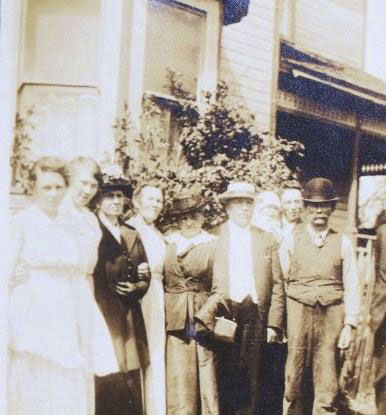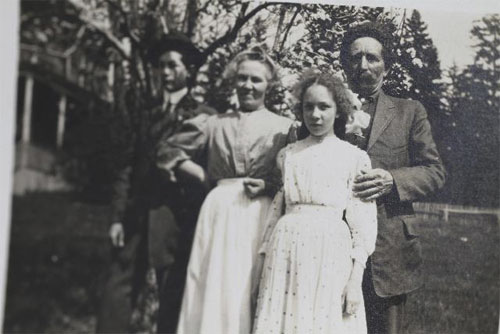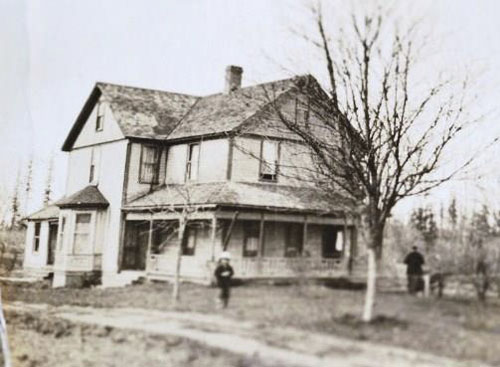
The Skogman family was one of a number of Scandinavian families who lived on the Sammamish Plateau in the early decades of the twentieth century. Between 1915 and 1928 they owned what we now know as the Reard-Freed house and property, but which they knew as the "big ranch." One of the family members, Ed Skogman, kept a diary during the family's years on the plateau which opens a window to life here nearly 100 years ago.
Olof Larsson (1856-1929) was born on February 13, 1856, in the town of Alvdalen, Sweden, about 180 miles northwest of the capital of Stockholm. His wife, Margit Andersdotter (1860-1936), was also an Alvdalen native. They were married in 1880 and had one daughter, Anna Wilhelmina "Minnie" Larsson (1881- ?) while still in Sweden. At some point between 1880 and 1882 they moved to the industrial city of Gothenberg, Sweden, in the southwestern part of the country, but in May 1882 the young family immigrated to America and settled in Brunswick, Minnesota. Olof became a U.S. citizen in 1885. Soon after, he changed his last name to Skogman.
The family farmed during their Minnesota days, and had three more children there: Victor (1884-1970), Edwin "Ed" (1895-1949), and Florence (1899-1945). In 1899 (not long after Florence was born) the family (sans Minnie, who had married by then) moved to Bainbridge Island and took up farming on a parcel of land at Port Madison, not far from Agate Pass. At some point Victor moved to Seattle, and between 1912 and 1914 worked as a deliveryman (using, at least initially, a horse-drawn delivery wagon) at the Bon Marche in downtown Seattle. About 1913 the rest of the Skogman family joined Victor in Seattle, and in October 1913, Victor married Christine Thompson (1893-1981).

(left to right): Edwin, Margit, Florence and Olof Skogman at their home on Bainbridge Island, c. 1910.
Ed developed tuberculosis, and the family was told they needed to move to fresher air. In October 1915 they bought an 80 acre farm that had been started by Jacob Reard some 20 years earlier on the plateau above Monohon, then a thriving community of 300 people. The entire family moved to their new farm during the last week of December 1915. Living in the house were Olof, Margaret, Victor, Christine, their infant son Clarence (1915-2000), Ed, and Florence.
And here we have a stroke of luck. Ed Skogman kept a small diary every year from 1912 through 1948. His daily entries of these early years, though brief, still tell a fascinating story of the Skogmans' days on the Plateau in the 1910s and 1920s. The family struggled through a particularly nasty winter in their first months on the farm (two feet of snow fell in a single storm in late January and early February 1916, one of the area's largest on record). They spent the early weeks rebuilding a chicken house on the property, putting up a new fence, and pruning trees. They bought cows and chickens for their new farm and hauled hay up the hill from Monohon by horse and wagon. There was a tremendous amount of daily physical labor involved in their lives -- as there was for anyone living here 100 years ago -- that is difficult to imagine today.
There were also some weird surprises. "Skunk in pantry," reports Ed's diary on January 6, 1916. But the family persevered. By summer their prune and apple trees were flourishing and they had two gardens growing a variety of produce, including tomatoes and potatoes. They sold many of their fruits and vegetables at the Monohon general store, as well as milk and cream from their cattle. By July, the family was busy cutting and hauling hay, and no longer had to go to Monohon to get it.
But while Ed was a hard worker, he was also quite a socializer. His diaries are replete with references of going to dances in various homes, and Victor and Christine Skogman also hosted dances in the large room of the second floor of their home. Ed also attended dances at the "Inglewood Club" and the "Pine Lake Club." He doesn't say where these clubs were, but the "Pine Lake Club" may have been in the old Pine Lake School house near the northeast corner of today's SE 24th Street and 228th Avenue SE; it was the scene of many social events during the 1910s. And he enjoyed other area social functions: "To picnic at Alexander's Point," reads his July 3, 1921, diary entry.

Late in 1919 Ed bought a newly-built house just north of Monohon, on the northeast corner of "Pine Lake Road" (SE 24th) and the "Redmond and Issaquah Road" (East Lake Sammamish Parkway). This house, which was approximately 1,300 square feet, came to be known in the Skogman family as the "little ranch," while the farm up the hill became the "big ranch." Brother Victor and his family initially lived at the little ranch and are recorded there in the 1920 Census, taken in January of that year. Ed moved there the following month, noting the occasion in his diary ("Living on my own ranch in Monohon," proudly reads his February 24, 1920, entry). In 1922 Ed signed over the house to Olof, who lived and farmed there until later in the 1920s. (Fortunately, the house was far enough north to escape the devastating Monohon fire of 1925.) Victor subsequently lived in the house until 1945, and the house itself survived until the final decades of the twentieth century.
Ed was a grocer for much of his life, and worked in several grocery stores, including stores in Selleck and Cumberland (located, respectively, east of Maple Valley and southeast of Black Diamond). But he also worked other jobs throughout his life. One of the more interesting ones was when he went to work in 1922 for the Fred S. Harris Company, an automobile dealer in Seattle. For nearly two years Ed sold cars in Monohon; he would leave in the morning, travel to Bellevue, catch the ferry to Seattle, pick up a car, ferry it back across Lake Washington to Bellevue and then drive it to Monohon, all in a single day. He also sold cars in Enumclaw and Selleck.
It's unclear from Ed's diaries when the Skogmans moved out of the big ranch. There is some suggestion that they may have rented the property out for the last few years that they owned it prior to Oscar Freed acquiring it in 1928. One Skogman story has a couple of them going to the ranch to run off a bootlegger. This is quite plausible. Freed later had a renter who was also a bootlegger, probably in the early 1930s; son Richard recalled in a 2005 interview going out to the farm and seeing a still discreetly hidden in a depression in the barn. During Prohibition (1916-1933 in Washington state) there were more than a few illegal stills on the plateau, and they were not viewed with any real stigma by the locals.
Olof died in 1929. Victor worked at the Monohon general store for a number of years as a bookkeeper. (The 1920 Census also shows that he was at that time working at the Monohon mill.) He moved to Redmond in 1945 and kept the books for the Redmond Grange until he retired. He died in 1970. Ed and his family moved to Alger (about ten miles south of Bellingham), where he operated a grocery store. However, Ed was plagued by health problems, and died in 1949 at the relatively young age of 54. But he left behind his diaries, which provide a one-of-a-kind glimpse into life here nearly a century ago.
—Phil Dougherty, September 22, 2010
Sources: Diaries of Edwin "Ed" Skogman, 1912-1948, in possession of Patti Bradfield, Redmond, Washington; Olof Skogman naturalization certificate, in possession of Patti Bradfield, Redmond, Washington; "Reard-Freed House," Sammamish Heritage Society website accessed September 15, 2010 (http://www.iinet.com/~shs/freed.html); Ancestry.com, 1920, 1930 United States Census, State of Washington, King County, Monohon Precinct, website accessed March 13, 2010 (www.ancestrylibrary.com); "Skogman, Christine Ingibjorg Thompson," Find A Grave website accessed September 18, 2010 (www.findagrave.com.); King County Tax Assessor Records, "Section 7, Township 24, N. Range 6, Tax Lot #9," in possession of Puget Sound Regional Archives, Bellevue, Washington; Phil Dougherty interview of Patti Bradfield, March 14, 2010, September 14, 2010, Redmond, Washington; Patti Bradfield email to Phil Dougherty, September 17, 2010, in possession of Phil Dougherty, Sammamish, Washington